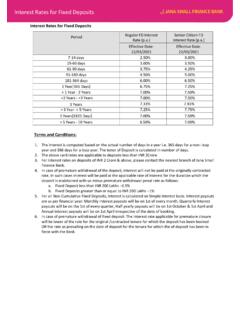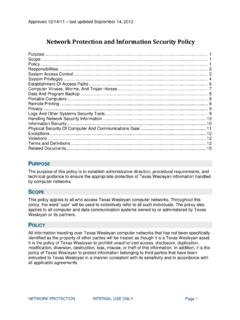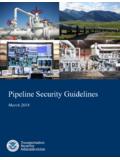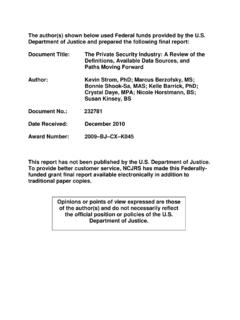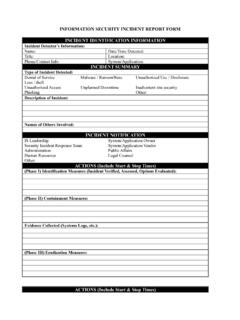Transcription of Information Security Policy - janabank.com
1 Information Security Policy Introduction The Information Security Policy provides an integrated set of protection measures that must be uniformly applied across Jana Small Finance Bank (JSFB) to ensure a secured operating environment for its business operations. Customer Information , organisational Information , supporting IT systems, processes and people that are generating, storing and retrieving Information are important assets of JSFB. The availability, integrity and confidentiality of Information are essential in building and maintaining our competitive edge, cash flow, profitability, legal compliance and respected company image. This Information Security Policy addresses the Information Security requirements of: i. Confidentiality: Protecting sensitive Information from disclosure to unauthorised individuals or systems;. ii. Integrity: Safeguarding the accuracy, completeness, and timeliness of Information ;. iii. Availability: Ensuring that Information and vital services are accessible to authorised users when required Other principles and Security requirements such as Authenticity, Non-repudiation, Identification, Authorisation, Accountability and audit ability is also addressed in this Policy .
2 Scope i. This Policy applies to all employees, contractors, partners, Interns/Trainees working in JSFB. Third party service providers providing hosting services or wherein data is held outside JSFB. premises, shall also comply with this Policy . ii. Scope of this Information Security Policy is the Information stored, communicated and processed within JSFB and JSFB's data across outsourced locations. Objectives The objective of the Information Security Policy is to provide JSFB, an approach to managing Information risks and directives for the protection of Information assets to all units, and those contracted to provide services Information Security Policy Ownership The Board of Directors of JSFB is the owner of this Policy and ultimately responsible for Information Security Responsibility To avoid conflict of interest formulation of Policy and implementation / compliance to the Policy to remain segregated. Therefore the Information Risk Management Department (IRMD) will be the owner of the Information Security (IS) Policy and Implementation responsibility to rest with IT.
3 Security Department under IT department. The Chief Information Security Officer (CISO) is responsible for articulating the IS Policy that Bank uses to protect the Information assets apart from coordinating the Security related Issues within the organisation as well as relevant external agencies. The CISO shall not be a member of IT department and shall be a member of Risk department. All the employees and external parties as defined in Policy are responsible to ensure the confidentiality, integrity and availability of Bank's Information assets. Information Risk Management Department (IRMD). IRMD to give recommendations regarding the Information Security risk and responsible for maintenance / review of the IS Policy and also for formulating/review of all sub policies derived from IS Policy . Policy Exceptions Refer to Exception handling procedure. Information Security Policy Periodic Review The Policy shall be reviewed every year or at the time of any major change in existing IT.
4 Environment affecting Policy and procedures, by CISO and placed to Board for approval. This Policy will remain in force until next review / revision. Policy Compliance Check Compliance review of IS Policy should be carried out by Internal/External auditor on a periodic basis. Inspection & Audit Division is responsible for monitoring compliance of IS Policy . The compliance report should be placed by IAD to the Audit Committee of Board. Information Security Governance Information Security governance consists of leadership, organisational structures and processes that protect Information and mitigation of growing Information Security threats Critical outcomes of Information Security governance include: 1. Alignment of Information Security with business strategy to support organisational objectives 2. Management and mitigation of risks and reduction of potential impacts on Information resources to an acceptable level 3. Management of performance of Information Security by measuring, monitoring and reporting Information Security governance metrics to ensure that organisational objectives are achieved 4.
5 Optimisation of Information Security investments in support of organisational Objectives It is important to consider the organisational necessity and benefits of Information Security governance. They include increased predictability and the reduction of uncertainty in business operations, a level of assurance that critical decisions are not based on faulty Information , enabling efficient and effective risk management, protection from the increasing potential for legal liability, process improvement, reduced losses from Security -related events and prevention of catastrophic consequences and improved reputation in the market and among customers. Information Security Policy Management Responsibility 1. Approve policies related to Information Security function 2. Ownership for implementation of board approved Information Security Policy 3. Ownership for establishing necessary organisational processes for Information Security 4. Ownership for providing necessary resources for successful Information Security 5.
6 Ownership for establishing a structure for implementation of an Information Security program (framework). Organisation Structure Information Security organisation shall comprise of the following 1. Board of Directors 2. Information Security Committee (ISC). 3. Business/Department Heads 4. Information Asset Owner 5. Chief Information Security Officer (CISO). 6. Chief Risk Officer (CRO). 7. Chief Technology Officer (CTO). 8. Asset Custodian 9. IT Security operations 10. IT Operation 11. Internal Audit Information Security Policy The Information Security Organisation is divided into 3 sections i. Executive Management Implementing effective Security governance and defining the strategic Security objectives of an organisation can be complex task. As with any other major initiative, it must have leadership and ongoing support from executive management to succeed. ii. Governance Governance is the set of responsibilities and practices exercise by the board and executive management with the goal of providing strategic direction, ensuring that objectives are achieved, ascertaining that risks are managed appropriately and verifying that the enterprise resources are used responsibly iii.
7 Implementer Ensuring that initiatives and existing operations adhere to policies is an area that the implementer is expected to manage. Information Security Policy Roles and Responsibilities The roles and responsibilities of the Information Security Organisation members are as follows 1. Board of Directors Approving the Information Security Policy 2. Information Security Committee (ISC). The MD shall be the chairman of the ISC. The ISC shall have representation from the following Departments CTO. CRO. CISO. Members from Internal Audit, HR, Legal, Finance and other departments should be called for the ISC meeting on need basis The ISC roles and responsibilities shall be as follows Developing and facilitating the implementation of Information Security policies , and procedures to ensure that all identified risks are managed within a bank's risk appetite. Approving and monitoring major Information Security projects and the status of Information Security plans and budgets, establishing priorities, approving procedures.
8 Supporting the development and implementation of a bank-wide Information Security management program Reviewing the position of Security incidents and various Information Security assessments and monitoring activities across the bank Reviewing the status of Security awareness programs Assessing new developments or issues relating to Information Security Requirement for generating effective metrics for measuring performance of Security control Reporting to the Board of Directors on Information Security activities Conducting regular ISC meetings (at least quarterly) and maintenance of MOM. Information Security Policy 3. Information Security Officer (CISO). Establishing, implementing, monitoring, reviewing, maintaining and improving Information Security Management System (ISMS). Reviewing the Security policies /procedures and suggesting improvements Coordinating the ISC meetings Providing consultative inputs to the ISC on Security requirements Coordinating Information Security initiatives in the organisation Driving and monitoring the ISC directives in the organisation Updating ISC about IS initiatives, issues and incidents Facilitating and Conducting risk assessments of Information Assets used and recommend mitigation controls Promote Security awareness amongst employees, customers and partners.
9 4. Business Heads Heads of Business Units are ultimately responsible for managing Information risk in their respective business as part of their wider risk management responsibilities Nominate Asset owner Providing resources and support to the Asset Owners for Information Security implementation in the business unit Information Security Policy 5. Information Asset Owner Information asset owners shall be allocated to each Information asset and shall ensure that Security processes associated with these assets are established. For data and IT systems, they are called as application owners. The asset owner or the application owner is usually the business owner. Each application should have an application owner (asset owner) who will typically be part of the concerned business function that uses the application. Responsibilities would include, but not be limited to: Assigning initial Information classification and periodically reviewing the classification to ensure it still meets business needs under guidance of Information Risk Management department (IRMD).
10 Ensuring Security controls are in place, as recommended by IRMD;. Reviewing and ensuring currency of the access rights associated with Information assets they own;. Determining access criteria and back-up requirements for the Information assets /. applications they own. An Information asset owner may delegate authority for the operation and protection of assets under their responsibility to an asset custodian. However, it will remain the responsibility of the asset owner to accept risk and to take appropriate steps to ensure that delegated authority is being responsibly applied 6. Asset Custodian An asset custodian shall be a member of the Information technology team A custodian shall typically, but not necessarily be confined to, assist the owner in the identification of control mechanisms, ensuring their development/purchase, implementation, maintenance and effective operation, reporting issues that affect the Information asset in the operational environment to the owner Together with the business owner, a custodian shall develop and maintain an Information asset inventory including Confidentiality, Integrity and Availability ratings in such a way that the relationship between business process and IT component is documented and known by both parties A business owner shall not relinquish accountability for risk management of the owned asset by delegation of responsibility Information Security Policy 7.
